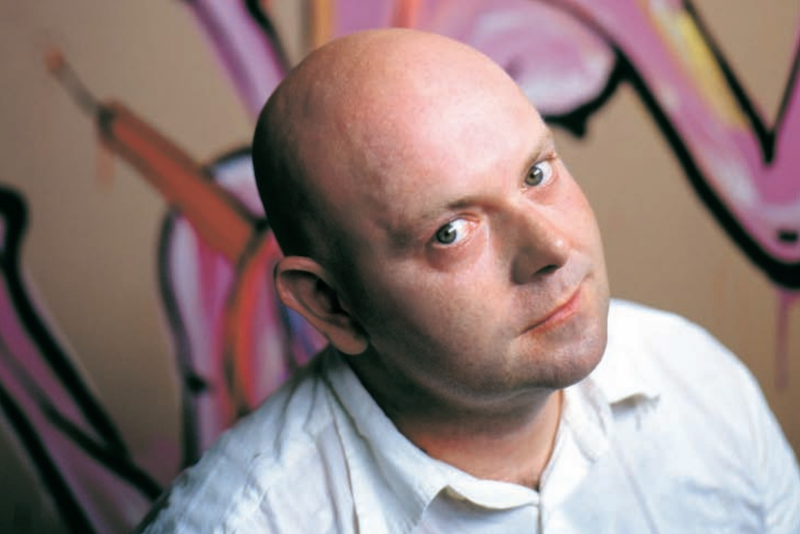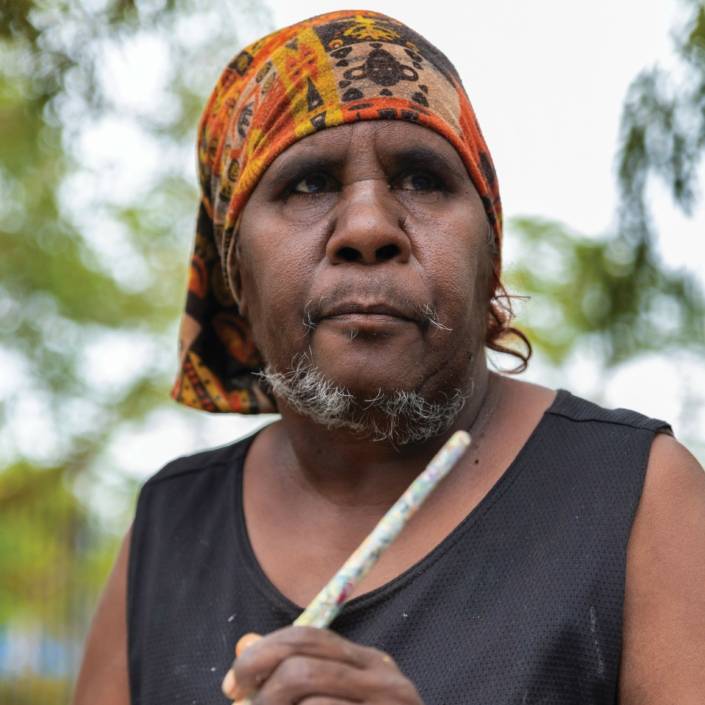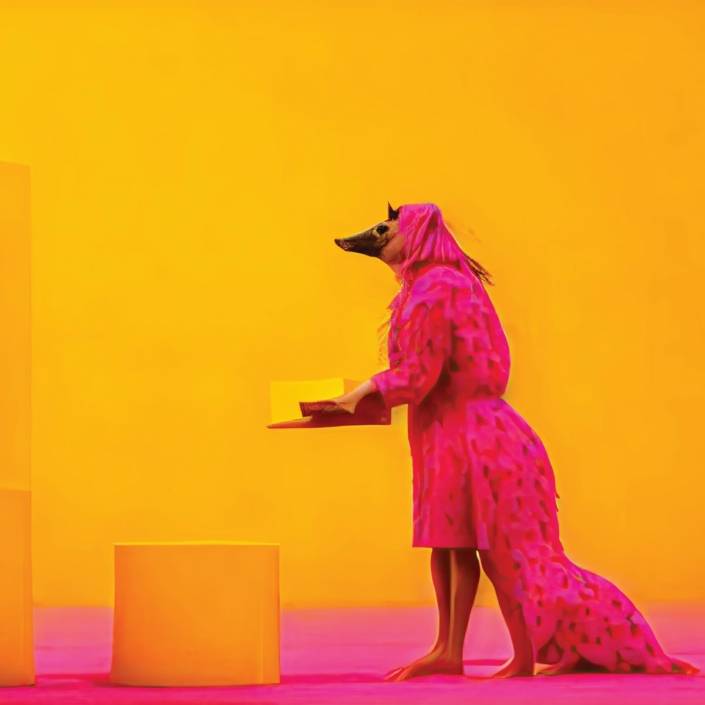Adam Cullen: When the Weird Turn Pro
Like gonzo journalist Hunter S Thompson, artist Adam Cullen refuses to bend the rules, writes Ashley Crawford.
Words: Ashley Crawford
Photography: George Fetting
There is never, ever, anything straightforward about tackling Adam Cullen. He can be charming and prickly, beguiling and secretive, enthusiastic and aloof. He can be holed up in his cabin in the mountains, the phone cut off as bushfires circle the compound. Or he can be swanning through the Museum of Contemporary Art, charming the pants off curators and critics alike. I’ve seen him bewilder and charm artist Tim Storrier with his knowledge of firearms and beguile such writers as Catharine Lumby and Ingrid Periz with his witticisms. He happily holds his own in conversation with both the erudite Edmund Capon at the Art Gallery of New South Wales and the somewhat more down to earth Mark ‘Chopper’ Read in a down-at-heels pub in Collingwood.
Indeed, very much like his work, Adam Cullen is a whirling mix of contradictions. He seduces and repels – both on canvas and in the flesh – in equal measure. Here is a painter whose sense of line, whose dexterity with colour, is undeniable, but who savages the outcome with viscous drips of uncontrolled paint; an artist who can render the female nude with sensual and erotic potential and then fill the sinuous lines with a repugnant, rotting, toxic green.
Despite having moments of seeming fashionable – he was one of the hot names, alongside artists Mikala Dwyer and Hany Armanious when grunge was of the moment in the early 90s – Cullen in many respects has never fitted into the agendas of the time. While he has tackled sculptural objects and installations, he remains at heart a painter. But where much contemporary Australian painting has become an illustrative posture of arcane intellectual conceits or technical wizardry via computer rendering, Cullen’s work remains unwaveringly personal. When Cullen is feeling bitter, his painting is acidic. When Cullen feels that the world is a humorous mistake, his painting takes on a devil-may-care silliness, albeit one that is perceptive in its cynicism.
Working on a book project with Cullen over the last year (as commissioning editor for the recently published monograph on Cullen by Ingrid Periz), it seemed that the gods of chaos were trailing the artist. There were dramas with dealers and a sizzling close call with bushfires (at one point he exclaimed that sparks had hit the house just before the telephone line went dead). At the same time there were offers from Melbourne galleries – he eventually settled with the prestigious Tolarno Galleries – and a new body of work that was being happily resolved. The chaos seemed to be grist for the mill; regardless of the battle, the paint would sooth the wounds in a Dorian Grey-like transference of angst.
As is by now well documented, Adam Cullen leapt to a more mainstream position in the art world by winning the Archibald Prize in 2000. There are three points that have become the Cullen canon, or alternatively the Cullen cliché. The first was the renown he gained from attaching a rotting pigs head to his leg at art school. The second was the rather unlikely – given the renowned conservatism of that prize – win of the Archibald for his portrait of actor David Wenham and the third is his headline-grabbing collaboration with Chopper Read for the children’s book, Hooky The Cripple. But Cullen has indisputably moved beyond these early moments, establishing a unique body of work and approach to painting all of his own.
There is a sense of despair running through the most recent work, but with his extraordinary vigour, Cullen manages to overcome the negatives, creating a world of leaping leprechauns and other bizarre figures, with hints of political savagery and heart-felt concern about the planet he inhabits.
In the 2004 monograph Scars Last Longer, which was launched at Tolarno Galleries to coincide with his first exhibition at that gallery last year, the author Ingrid Periz refutes the bad boy image, revealing an artist of extraordinary skill and sensitivity.
“Dead cats, bloodied ’roos, inflatable men and headless women,” she writes, “Sydney painter Adam Cullen likes to conjure up the elements of a place called ‘Loserville’, pipe in some lounge music and depart the scene, but not for anywhere better.”
There have been ongoing themes in Cullen’s work, ranging from the impact of relationships through to his Irish cultural heritage. This was powerfully expressed in his most recent show with a dark, brooding abstracted painting, The Blanket Men, based on the 1981 IRA hunger strike led by Bobby Sands.
Cullen’s highly personal language ends up becoming universal. His schoolboy humour is matched by a highly sophisticated expression of moods and responses to society, moments of anger balanced with hilarity. And it is all expressed with powerful, gestural black line work and bold colouration.
Added to Cullen’s painterly language is a cultural mélange of influences – hints of Japanese manga, Antipodean cliché (kangaroos are a favourite), and Irish leprechauns. But Cullen sees his work firmly in the tradition of European art. “I’ve always seen art as essentially being about all of the paintings in all of the museums in Europe,” he says. “It probably isn’t obvious, but I’ve always been intrigued by the history of painting being created for the Church, for the clergy. My work is to annoy the Church, to give them something to think about, a chance for spiritual catharsis … on a practical as well as metaphorical level.”
For Cullen, in some respects the art world has become a religious edifice as well, the curators the altar boys, the gallery directors the high priests.
The Blanket Men was quite knowingly a work about religious fracture as well as personal connection. “It’s a religious war,” he says of the battle in Ireland. “I have a second cousin once removed who was involved in that hunger strike. Our family called it The Good War. How could Margaret Thatcher let a Member of Parliament die in one of her jails? It’s outrageous.”
Cullen notes that when visiting major paintings in Europe one sees central themes that reflect a dark aspect of human history. “It’s all about war, rape or torture,” he says. “Contemporary art lost those central themes when those idiots in France started painting nothing but pretty colours.
“But information has also changed. It’s obviously travelling a lot faster and in the process it has become overly aestheticised.”
When painting has to compete with the morass of information supplied by the internet, television, cinema and advertising it can be rendered impotent, says Cullen. “I think if you can provide work as fast and as intelligent as those things you can compete. Despite what happens in the future most people will still want to hang a picture to look at in their home.”
Cullen believes his work is to some extent a filter between his imagination and the real world. “It’s almost autobiographical in the way that Caravaggio dressed up his friends to illustrate universal stories,” he says. His decidedly painterly approach, as opposed to Caravaggio’s considered surfaces, reflects the times, he says. “The space we live in is a quasi filmic space and that’s how we see things now. It’s like a re-run.”
Accordingly Cullen remains true to his central subjects and his own way of relating to the people and creatures he portrays. “The work is a continuation of animals and people in psychological and physical decomposition.”
Cullen’s depiction of animals serves as an expression of the decay of the world around him. “Animals are almost ways of portraying the human state, beasts of burden. But I also see them in an animistic or almost shamanistic relationship. I see them in human terms, states of being, you know, handsome as a horse, filthy as a pig.”
His most recent work continues his fascination with a graphic lineage: “I’m looking at a lot of 17th Century Japanese erotic prints, cartoon – I’ve always enjoyed animation, the average kids’ cartoons, the infantile pulp in the morning which I think is just evil – there’s little difference between that and the evening news.”
But Cullen’s more dystopian imagery is far from fantasy. “It’s not just imagined,” he says. “I hear horrendous shit and I have to paint it.
“I do a lot of work for charities but it’s almost always for environmental issues or animal causes.
We’re busy wiping out the environments animals live in and they don’t have that much help.”
Cullen is clearly disturbed by the insensitivity of the human race, even his fellow artists who, he believes, have become overly conservative.
“I teach at the National Art School one day a week and a lot of the artists I meet are so politically unaware. Most artists have become soft-cock conservatives. That’s why Mike Parr remains so fantastic. He’s always consciously trying to stick a pin in every bubble.”
Cullen obviously hopes that to some extent his work is a wake up call to an overly bourgeois world and like many of his generation he was saddened to hear of the death of maverick gonzo journalist Hunter S. Thompson.
“I’ve always loved and related to his famous quote: ‘When the going gets weird the weird turn pro’,” he says.
And like Thompson, Cullen refuses to find an easy route via comfortable imagery.
“I haven’t succumbed,” he says. “I still paint and do exactly what I want to. I don’t have to bend.”











